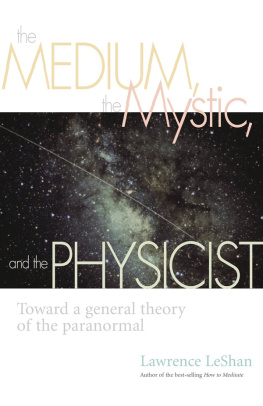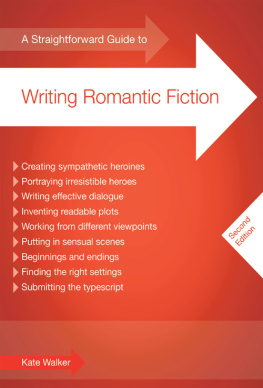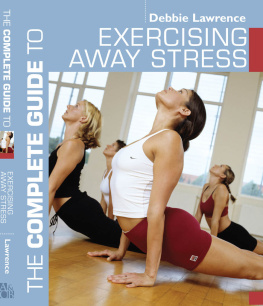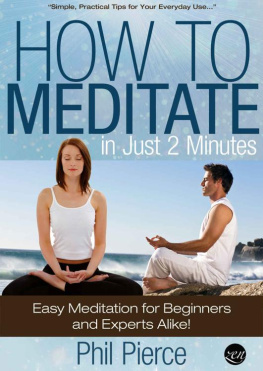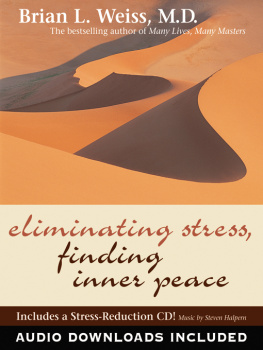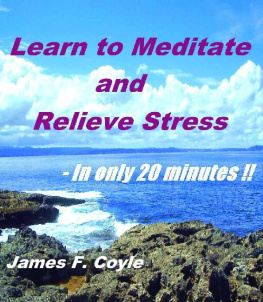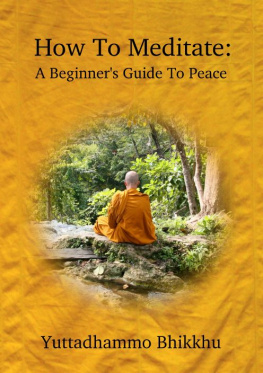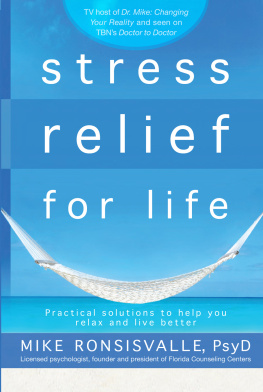Lawrence LeShan - How to Meditate: A Guide to Self Discovery
Here you can read online Lawrence LeShan - How to Meditate: A Guide to Self Discovery full text of the book (entire story) in english for free. Download pdf and epub, get meaning, cover and reviews about this ebook. year: 2017, publisher: Little, Brown and Company, genre: Religion. Description of the work, (preface) as well as reviews are available. Best literature library LitArk.com created for fans of good reading and offers a wide selection of genres:
Romance novel
Science fiction
Adventure
Detective
Science
History
Home and family
Prose
Art
Politics
Computer
Non-fiction
Religion
Business
Children
Humor
Choose a favorite category and find really read worthwhile books. Enjoy immersion in the world of imagination, feel the emotions of the characters or learn something new for yourself, make an fascinating discovery.

- Book:How to Meditate: A Guide to Self Discovery
- Author:
- Publisher:Little, Brown and Company
- Genre:
- Year:2017
- Rating:3 / 5
- Favourites:Add to favourites
- Your mark:
- 60
- 1
- 2
- 3
- 4
- 5
How to Meditate: A Guide to Self Discovery: summary, description and annotation
We offer to read an annotation, description, summary or preface (depends on what the author of the book "How to Meditate: A Guide to Self Discovery" wrote himself). If you haven't found the necessary information about the book — write in the comments, we will try to find it.
How to Meditate: A Guide to Self Discovery — read online for free the complete book (whole text) full work
Below is the text of the book, divided by pages. System saving the place of the last page read, allows you to conveniently read the book "How to Meditate: A Guide to Self Discovery" online for free, without having to search again every time where you left off. Put a bookmark, and you can go to the page where you finished reading at any time.
Font size:
Interval:
Bookmark:
How to Meditate
A practical guide to meditation. Drawing upon such disciplines as Zen, Sufism, yoga, and Christian and Jewish mysticism, LeShan describes specific exercises and programs ranging from Breath Counting and simple mantras to group movement and sensory awareness.
Sam Love, Washington Post Book World
This is one of the most sensible books on the subject. LeShans wide experience and sound scholar ship are evident in each helpful chapter.
Library Journal
If you have started your journey (or even if youre just considering it), How to Meditate is recommended equipment for the first steps.
Hank Basayne, Association for Humanistic Psychology
Copyright 1974 by Lawrence LeShan
Foreword copyright 2017 by Rick Hanson, PhD
Cover design by Amy Goldfarb
Cover and interior leaf image (IMA) Minoru Toi / Photonica
Cover copyright 2017 Hachette Book Group, Inc.
Hachette Book Group supports the right to free expression and the value of copyright. The purpose of copyright is to encourage writers and artists to produce the creative works that enrich our culture.
The scanning, uploading, and distribution of this book without permission is a theft of the authors intellectual property. If you would like permission to use material from the book (other than for review purposes), please contact permissions@hbgusa.com. Thank you for your support of the authors rights.
Little, Brown and Company
Hachette Book Group
1290 Avenue of the Americas, New York, NY 10104
littlebrown.com
twitter.com/littlebrown
facebook.com/littlebrownandcompany
First ebook edition: October 2017
Little, Brown and Company is a division of Hachette Book Group, Inc. The Little, Brown name and logo are trademarks of Hachette Book Group, Inc.
The publisher is not responsible for websites (or their content) that are not owned by the publisher.
The Hachette Speakers Bureau provides a wide range of authors for speaking events. To find out more, go to hachettespeakersbureau.com or call (866) 376-6591.
ISBN 978-0-316-56174-7
E3-20170823-JV-PC
To Max Grossman,
who taught me that the opposite of injustice is
not justice, but love.
I began meditating in 1974 as a senior in college, curious about this seemingly exotic practice. I read a few books for background, including The Perennial Philosophy and The Three Pillars of Zen, headed up into the foothills near my home with my bamboo flute and long hair, sat down in the tall grass, and tried to stop my mind. Good luck with that! The grass was moving in the wind, and my mind was moving even more. I was focusing on the sensations of breathing: chest rising, chest falling, up and down, up and down. Against that steady backdrop, the roaring cascade of thoughts and feelings and weird little mental movies was painfully obvious. It wasnt any different from my usual stream of consciousness. Meditation simply made it apparent. If this was my mind, why couldnt I turn it off? It was frustrating.
But other things were happening as well. There was a relaxing and a calming in my body. I could step back from the rushing stream of consciousness to watch it, like I was sitting on the banks of a river rather than being swept away by it. Sometimes worries or frustrations or old hurts from childhood would bubble up to the surface, and these, too, could flow along, easing and releasing and passing away. My breath rose and fell and thoughts and feelings ebbed and flowed, and these changes revealed by contrast an underlying open spaciousness of awareness that was itself unchangingand was accompanied by a stable sense of happiness, love, and peace. This felt like a place to rest, a place to stand, a place to receive life and meet it. Even though meditating was often challenging, it felt like coming home.
Of course, back then I had little idea about how to meditate. As I was fumbling about in 1974, Lawrence LeShan was publishing his classic book on this subject. Its a quiet masterpiece. It never shouts. Dr. LeShans words are calm and warm and clear, and they quiet the mind as you read them.
But he will never put you to sleep. The combination of calmness and alertness that he says is the essence of meditation also characterizes his book. He takes us on a tour of the worlds contemplative traditions, moving nimbly from the prayers of Christian saints to the mantras of Hindu ascetics to the Koans of Zen Buddhists. His critiques of false gurus, weekend enlightenment training, and airy-fairy hocus-pocus are sharp and funny, and as relevant today as they were to those riding the waves of human potential in the 1970s. He also covers secular meditative practices, such as progressive relaxation and observing the breath, that have become widespread in the past several decades and used routinely in workplaces, classrooms, and hospitals.
Dr. LeShan describes in crisp practical detail how to do a variety of meditative exercises. He explains the differences among methods and their benefits and potential pitfalls. But his book is not a mere cookbook. He embeds his central topicthe how of meditationin a fascinating discussion of the what and especially the why of meditation as he explores mystical experiences, the collision of science and religion, shifts of perspective in the middle of everyday life, and the longing for a reliable happiness. Throughout all this, wonderfully, he does not tell a reader which practice to do. Or more exactly, he tells the reader to do whatever practice is most enjoyable and fruitful. He is informal, friendly, and encouraging. Still, he pulls no punches as he emphasizes the need for effort and sustained practicelikening meditation to physical exercise: if we want the results, we need to do the work. His honesty is refreshing and it makes his advice credible: we can trust the results of meditation since well have earned them.
These changes in the mind involve changes in the body, particularly in the brain. At the time this book was written, scientists had found already that regular meditation produced physical results, including deep relaxation, reduced stress physiology, and shifts in brain wave patterns. Over the past several decades, weve learned that meditation also builds up neuronal connections in key regions in the brain:
prefrontal areas behind the forehead that help regulate attention, emotion, and action
the insula, on the inside of the temporal lobes, which promotes self-awareness as well as empathy for others
the hippocampus, deep in the center of the head, which is vital for putting things in context and calming down stress reactions
Additionally, meditation increases activation in the left prefrontal cortex, which is associated with a greater focus on opportunities and more positive emotions. Long-term practice also seems to protect the telomeres that form caps at the end of the chromosomes deep in the nuclei of every cell in the body. This is an important finding since telomere shortening is linked to age-related illnesses and mortality.
Meditation changes the brain in part through its quintessential training of attention, which William James described as the education par excellence. Neurons that fire together, wire togetherespecially for what we pay attention to. Attention is like a spotlight, illuminating what it rests upon and, like a vacuum cleaner, sucking that information into the nervous system. This is experience-dependent neuroplasticity, the material nervous system designed by evolution to be changed by the immaterial information moving through it. In meditation, we keep attention on what is useful and disengage from what is not. In this process, we gradually learn to be more mindful while also cultivatingliterally in the brain and bodythe wholesome qualities of what weve meditated upon, which might be a sense of calm strength, compassionate wishes for others, or an intimation of something sacred, even divine.
Font size:
Interval:
Bookmark:
Similar books «How to Meditate: A Guide to Self Discovery»
Look at similar books to How to Meditate: A Guide to Self Discovery. We have selected literature similar in name and meaning in the hope of providing readers with more options to find new, interesting, not yet read works.
Discussion, reviews of the book How to Meditate: A Guide to Self Discovery and just readers' own opinions. Leave your comments, write what you think about the work, its meaning or the main characters. Specify what exactly you liked and what you didn't like, and why you think so.


